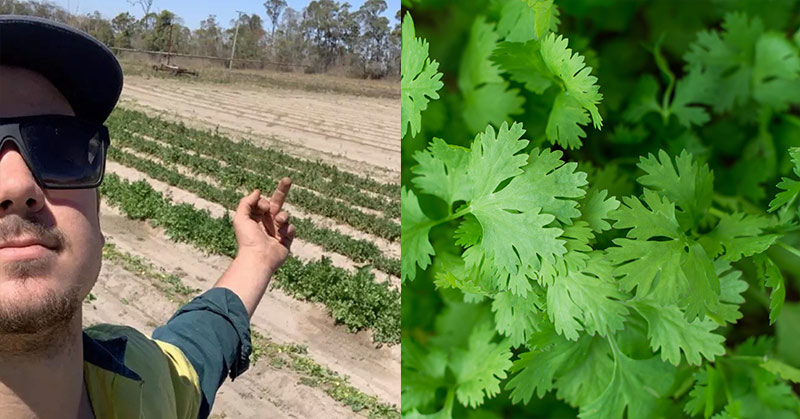Cilantro is one controversial plant, I’ll give it that. If it’s incorporated into any meal meant for a large group of people, get ready for an Oscar-worthy drama to unfold. Some people would enjoy the meal and even compliment the chef, while others would turn up their noses at it, walk away or even rush to the bathroom to turn out their insides.
It’s that much of a problem.
I remember how this herb was used as a part of so many dares growing up, as many of us thought it was so bitter or soapy. Fun fact: In the UK, its called coriander [1]. However, coriander is technically the name of the entire plant, while cilantro is the Spanish word for the leaves of the plant.
Cilantro would normally add a citrusy flavor to a dish, but not everyone perceives it this way. About 10% to 20% of people have a genetic predisposition to perceiving its taste in a negative way. Tastes can have a wide range of bitter stuff from dishwasher soap to dirt and rusty metal to cat pee (what does cat pee even taste like?). While cilantro is not toxic, some people can react so strongly you’d think it might be.
The Hatred Holiday
Well, there’s not much you can do about cilantro than just hate and avoid it. The coriander plant is grown in nearly all parts of the world and its leaves can also go by the names Mexican or Chinese Parsley. It may seem like its everywhere, but there is good news for those who dislike the herb, there’s a day set aside for you to celebrate your hatred for it, and it was February 24 [3].
In 2017, A Facebook group called “I Hate Coriander” decided Feb 24 was going to be their day to thrive and bask in cilantro hatred. While a lot of people think this group is a joke, they are actually not. They have a purpose and it’s to let people know that NOT EVERYONE CAN STOMACH CORIANDER. It makes them sick and shouldn’t be added to every meal as though it’s as common as salt.
The group’s administrator wrote: “There are many of us, we are strong, we are organized, we are over 10 percent of the world’s population that HATE CORIANDER! We are also reasonable people and our one demand is as fair as it is simple. Restaurants of the world, if your dish contains coriander, state it on the menu. We will launch a scathing campaign to name and shame eating establishments who are ignorant to the needs of the 10 percent. We’re not saying don’t serve it, we’re saying correctly notify your customers who stand to be affected by the soapy disgustingness of the devil’s herb.”
Why does Cilantro taste awful to some people?
Cilantro contains aldehydes, naturally-occurring compounds that are found in plants, perfumes and also as a by-product of soap. They are not always detected in foods but in a large quantity, they may have a pungent odor and an even worse taste.
A 2012 study conducted by researchers from Cornell University confirmed that the variation of an olfactory receptor gene called OR6A2 causes some people to detect aldehydes in cilantro [4]. They’ll process this taste as several awful things like soap, metal, and dirt. This particular study with a sample size of 11,851 participants suggests that most people who have this gene are of the European population.
According to the paper, the chances of inheriting this gene mutation is low. They wrote, “We also estimate the heritability of cilantro soapy-taste detection in our cohort, showing that the heritability tagged by common SNPs is low, about 0.087.”
Only people with the gene variation will be offended by the taste of cilantro. Some studies have suggested that the world population with this genetic factor is about 21%, concentrated in East Asia and North America [5].
Getting over the soapy taste
Cilantro/coriander is rich in a variety of vitamins and minerals which include manganese, iron and magnesium, Vitamin C, Vitamin K, and also dietary fiber and protein. It also contains small amounts of calcium, phosphorus, potassium, thiamin, niacin and carotene.
To get over the cilantro taste, you might have to cook or use it differently. This would significantly reduce the nutritional value, but it’s still worth a shot. You could slice or cut up the leaves and wash them to get rid of the soapy taste. Also, you could try cooking it before use.
If you hate cilantro so deeply that you can’t even touch it, you’d have to replace it with other vegetables The most common replacement is parsley. As a kid, I had to taste both veggies to know the difference because parsley looks a lot like cilantro. Then there’s the delicious French herb Tarragon, dill, and of course, kale.
To be fair to everyone, when we’re cooking for a large group of people and we’re not sure who’s cilantro-intolerant, it’s best not to incorporate the vegetable into any dish and serve it as a choice topping. Also, if we must cook any dish with it, it would cost nothing to let everyone know. Cilantro can ruin a person’s day and it’s always better to give them a choice.

